
Bromus arvensis, the field brome, is a brome grass native to Europe and Asia. The specific epithet arvensis is Latin, meaning "of cultivated land".
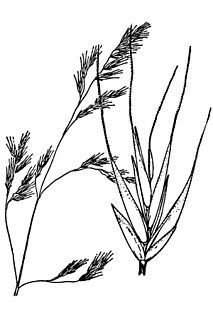
Festuca occidentalis is a species of grass known as western fescue. It is native to much of the northern half of North America and is most widely distributed in the west. It is most often found in forest and woodland habitat. The specific epithet occidentalis is Latin, meaning "western".

Bromus madritensis is a species of brome grass known by the common name compact brome. The specific epithet madritensis refers to Madrid, Spain. It has a diploid number of 28.
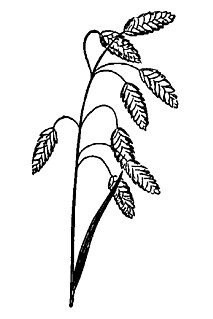
Bromus briziformis is a species of brome grass known by the common name rattlesnake brome. The specific epithet briziformis comes from the resemblance of the grass to grasses of the genus Briza, particularly Briza maxima. The common name is derived from the resemblance of the spikelets to the rattles of rattlesnakes. The grass has a diploid number of 14.

Bromus catharticus is a species of brome grass known by the common names rescuegrass, grazing brome, prairie grass, and Schrader's bromegrass. The specific epithet catharticus is Latin, meaning cathartic. The common name rescuegrass refers to the ability of the grass to provide forage after harsh droughts or severe winters. The grass has a diploid number of 42.

Bromus ciliatus is a species of brome grass known by the common name fringed brome. It is native to most of North America, including most of Canada, most of the United States except for some portions of the South, and northern Mexico. It is a plant of many habitats, including temperate coniferous forest. The specific epithet ciliatus is Latin for "ciliate", referring to the delicate hairs of the leaf blades.

Bromus kalmii, the Arctic brome or prairie brome, is a species of brome grass. It is a native bunchgrass in the North-central and Northeastern United States, the Great Lakes region, and eastern Canada. The specific epithet kalmii refers to its discoverer Pehr Kalm.

Festuca vivipara, the viviparous sheep's-fescue, is a species of grass native to northern Europe, northern Asia, and subarctic North America. The specific epithet vivipara is Latin, referring to the florets' alteration to leafy tufts. The plant can have a diploid number of 28, 49, 56, or 63, though numbers of 21, 35, and 42 have also been reported.

Bromus erectus, commonly known as erect brome, upright brome or meadow brome, is a dense, course, tufted perennial grass. It can grow to 120 centimetres (47 in). Like many brome grasses the plant is hairy. The specific epithet erectus is Latin, meaning "erect". The diploid number of the grass is 56.
Melica racemosa is a species of grass that is endemic to South Africa.

Bromus nottowayanus, the Nottoway Valley brome or satin brome, is a brome grass native to North America. The specific epithet nottowayanus refers to the Nottoway Valley. The grass has a diploid number of 14.

Bromus japonicus, the Japanese brome, is an annual brome grass native to Eurasia. The grass has a diploid number of 14.
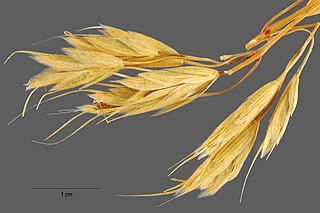
Bromus squarrosus, the rough brome, is a brome grass native to Russia and Europe. The specific epithet squarrosus is Latin, meaning "with spreading tips". The grass has a diploid number of 14.

Festuca brachyphylla, commonly known as alpine fescue or short-leaved fescue, is a grass native to Eurasia, North America, and the Arctic. The grass is used for erosion control and revegetation. The specific epithet brachyphylla means "short-leaved". The grass has a diploid number of 28, 42, or 44.
Festuca saximontana, the rocky mountain fescue or the mountain fescue, is a perennial grass native to North America. The specific epithet saximontana is Latin and means "of the Rocky Mountains". The grass has a diploid number of 42.
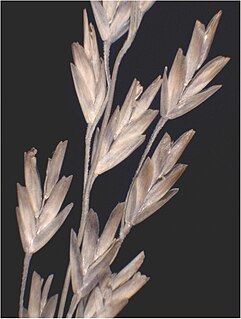
Puccinellia fasciculata, or Borrer's saltmarsh grass, is an annual grass native to coasts of Europe and introduced to the northern east coast of North America. Its diploid number is 28.
Puccinellia laurentiana is a perennial grass which grows on gravelly seashores in south-eastern Canada. Its specific epithet "laurentiana" refers to the Gulf of St. Lawrence, where it grows.
Puccinellia macra is a perennial grass which grows on the coasts of south-eastern Canada. Its specific epithet "macra" means large, referring to its tall stature.
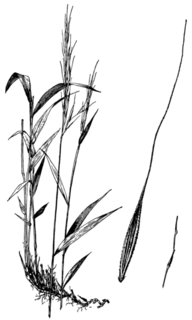
Brachyelytrum erectum, known as the southern shorthusk or the southern long-awned woodgrass, is a perennial grass native to North America. Its specific epithet "erectum" refers to the erect culms of the grass. Its diploid number is 22.
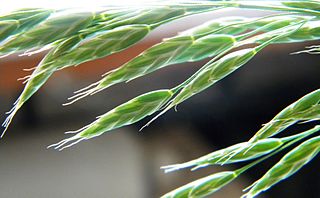
Bromus racemosus, the smooth brome or bald brome, is a species of flowering plant in the family Poaceae. It is native to subarctic and temperate Eurasia, and widely introduced elsewhere, including North America, Iceland, the Southern Cone of South America, the Korean Peninsula, Australia, and New Zealand. It grows in alkaline meadows and in waste places.















